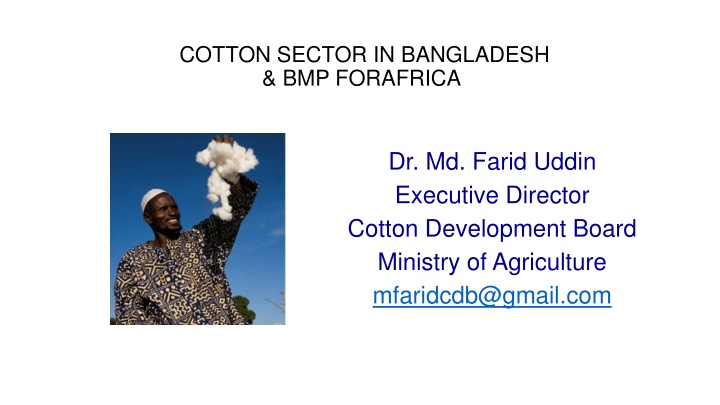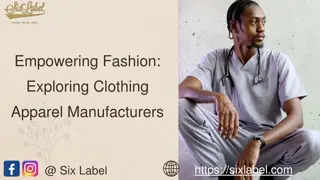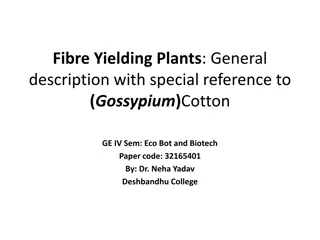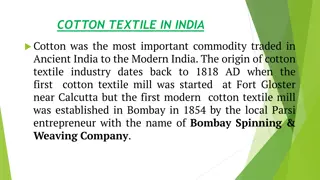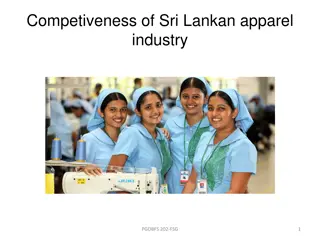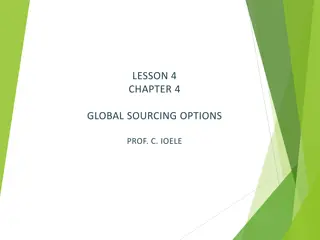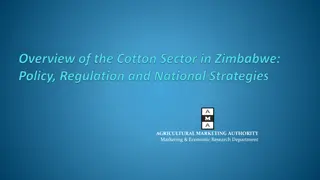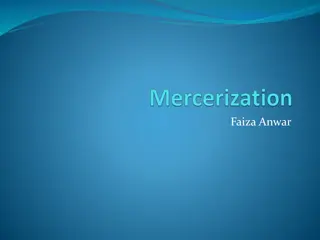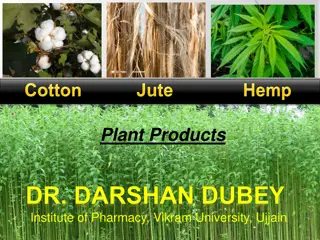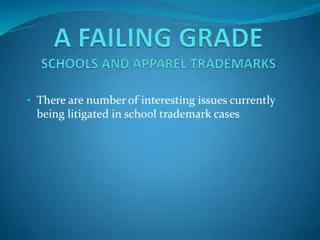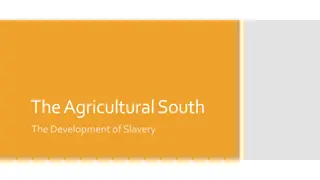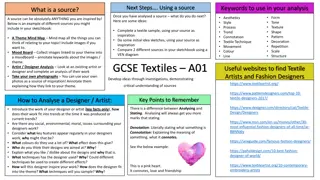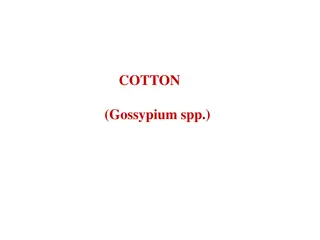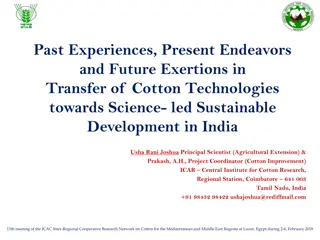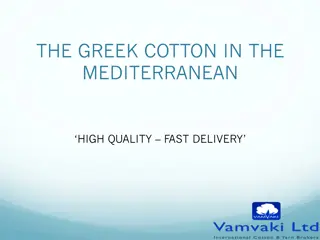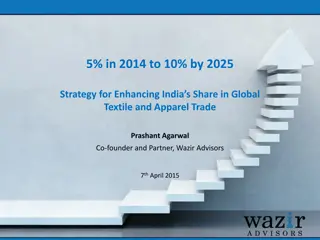Overview of Bangladesh's Key Sectors - Cotton, Agriculture, Textile & Apparel Industry
Bangladesh plays a significant role in the global cotton production, boasting a strong agricultural sector and a thriving textile and apparel industry. The country's achievements in rice, vegetable, and fish production, coupled with its economic growth and poverty reduction efforts, have garnered international recognition. With a focus on sustainable development, Bangladesh continues to make strides in various sectors, contributing to its emergence as a key player on the world stage.
Download Presentation

Please find below an Image/Link to download the presentation.
The content on the website is provided AS IS for your information and personal use only. It may not be sold, licensed, or shared on other websites without obtaining consent from the author.If you encounter any issues during the download, it is possible that the publisher has removed the file from their server.
You are allowed to download the files provided on this website for personal or commercial use, subject to the condition that they are used lawfully. All files are the property of their respective owners.
The content on the website is provided AS IS for your information and personal use only. It may not be sold, licensed, or shared on other websites without obtaining consent from the author.
E N D
Presentation Transcript
COTTON SECTOR IN BANGLADESH & BMP FORAFRICA Dr. Md. Farid Uddin Executive Director Cotton Development Board Ministry of Agriculture mfaridcdb@gmail.com
Africa in the global Cotton production From 100 countries in the world producing cotton, 25 are from Africa 53 counties in Africa, then almost 50% of them produce cotton Africa contributes approximately 6% of the global cotton supply 10 countries from West and Central Africa contribute 4% of the global cotton supply Rainfed and hand picked cotton Bangladesh imports 18% cotton from African countries
Bangladesh Agriculture at a Glance Bangladesh Agriculture at a Glance 4thposition in Rice production of world 3rdposition in vegetable production of world 4th position in fish production of world Self sufficient in food production BRRI released 91 HYV rice varieties BRRI released Zinc enriched variety Research and Development on Golden rice Bangladesh will withdraw from LDC list in March 2018. Bangladesh is going to be middle income country in vision 2020-2021
Bangladesh in the Spotlight Goldman Sachs Included Bangladesh in the Next 11 emerging countries JP Morgan lists Bangladesh among its Frontier Five emerging economies Bangladesh has demonstrated a consistent GDP growth of 7.05% in 2016-17 It steadily maintained a strong GDP growth of 6+ % over for the last 20 years. From 1990 to 2015, the incidence of poverty is reduced to 50%
Bangladesh Textile and Apparel Industry Bangladesh has shown a phenomenal growth in the Textile and Apparel Sector during the last twenty years. For Apparel Export Bangladesh is No. 2 in the world With about $28.15 billion exports in 2017, Textile and Apparel sector is the most vital industrial sector in the country They represent 13 percent of GDP and around 86 percent of total exports.
CONTRIBUTION OF TEXTILES IN BANGLADESH: Investment in the Primary Textile Sector: over 4.5 billion US$. Value addition in knit & woven RMG are over 70% & 35% respectively Textile sector contributes more than 13% in GDP. Over 86% of the export earning comes from Textiles & Textile related products. Around 90% yarn demand for knit RMG & 35-40% yarn demand woven RMG are met by Primary Textile Sector (PTS).
CONTRIBUTION OF TEXTILES IN BANGLADESH CONTRIBUTION OF TEXTILES IN BANGLADESH Local fabric demand & the yarn demand for handloom are also met by Primary Textile Sector (PTS). Backward & Forward linkage industries provide employment for more than 5 million people where 80% are female. PTS industries producing around 1200 MW power through Captive Generator. Generate huge cliental base for Banking, Insurance, Shipping, Transport, Hotel, Cosmetics, and Toiletries & related economic activities.
Global Majors RMG Market Players Source: World Trade Statistical Review 2017
Number and Employment in RMG of Bangladesh NUMBER OF GARMENT FACTORIES 5876 4222 4296 4328 4482 EMPLOYMENT IN MILLION WORKERS 4 4 4 4 4 YEAR 2012-13 2013-14 2014-15 2015-16 2016-17
TOTAL EXPORT AND EXPORT OF RMG OF BANGLADESH TOTAL EXPORT OF BANGLADESH (IN MILLION US$) 27027 30187 31209 34257 34656 EXPORT OF RMG % OF RMG S TO TOTAL EXPORT YEAR (IN MILLION US$) 21516 24492 25491 28094 28150 2012-13 2013-14 2014-15 2015-16 2016-17 79.61 81.13 81.68 82.01 81.23
Factors triggered to RMG Three synergic factors triggered the textile and Apparel boom in Bangladesh. Resources Opportunities and Policy decision.
Factors that triggered to RMG Resources Abundant labor forces A competitive advantage in producing labor intensive goods. Low cost energy and natural gas Opportunities DUTY FREE access to European market through Multi Fibre Arrangement (MFA).
Factors that triggered to RMG Policy decision Elimination or reduction of import tariffs on necessary raw materials Simplification of customs procedure The Market expansion measures
Government Support to RMG Avoidance of double taxation for joint venture projects Income tax exemption for up to three years for foreign technicians Duty free facilities on dyes and chemicals Duty free import of capital machinery Closer monitoring of linkage in the market Appointment of advisory committee to represent the industry to the government Improvement of research and computer technology etc
Core Advantages Price Price attractiveness is the first and foremost reason of purchasing from Bangladesh Capacity Bangladesh has the capacity for high volume supply in market Bangladesh has 4822 RMG factories Indonesia has 2450 RMG factories Vietnam has 2000 RMG factories Cambodia has 260 RMG factories
RMG Factories by Employment Textile and Spinning Mills- Yarn Manufacturing Mills: 425 Fabric Manufacturing Mills: 796 Dyeing-Printing-Finishing Mills: 240
Industry Strength 30 years of experience & reputation in garment manufacturing Competitive Price International standard quality Vibrant population, 70% below 40 years age, quick learning & dedicated Irresistible & resilient entrepreneurial spirit Duty free market access in most of the developed countries & PTA in India, China, Korea, Malaysia
Industry Strength Rapid adoption of environment friendly, energy efficient and green concepts Rapidly developing backward linkage: Washing-Dying- Finishing-Embroidery, etc. Versatility of factories to produce different type of products Increasing trend of direct sourcing through local liaison offices at Dhaka
Three independent associations are responsible for the textile sector: Bangladesh Textile Manufacturers Association (BTMA), Represents spinners, woven fabric manufacturers and dyeing units; Bangladesh Garment Manufacturers and Exporters Association (BGMEA), Represents the RMG sector, primarily the cutting and sewing units; and Bangladesh Knitwear Manufacturers and Exporters Association (BKMEA), Represents the knitwear fabric manufacturers, the fabric dyeing units and the knit garment cutting and sewing units. Involvement of three Ministries in Apparel sector Ministry of Textile and Jute, the Ministry of Finance and the Ministry of Commerce
Total Textile Process at a Glance Raw cotton is the starting point of textile process in Bangladesh
COTTON IMPORT COTTON IMPORT Total Import Total Import- -7.2m.bale 7.2m.bale 10% 7% India CIS Africa USA Others 46% 18% 19%
Challenges to Cotton Production in Africa Smaller scale of production Limited access to good quality seeds Heavy reliance on insecticides Decreasing soil fertility Increasing production costs Volatile markets Our experience in Bangladesh might be useful for the cotton research and development in Africa
Development of cotton sector in Africa Increasing the scale of production: -Larger scale projects and a better support by national services and policies will definitively contribute to bring down production costs, increase productivity Improving access to good quality seeds: Public research institutes capacity need to be strengthened to produce sufficient quantity of good quality seed Promoting IPM practices: -A country-specific practical training programme for smallholders and export-oriented farmers needs to be developed. -smallholders should be first on GAP and some the basic principles of IPM, whereas the focus for export-oriented farmers can be fully on IPM.
Development of cotton sector in Africa Development of cotton sector in Africa Adaptation of Integrated soil fertility management practices: -Integrated Soil Fertility Management practices need to be promoted combining agronomic practices relating to crops, mineral fertilizer - organic inputs and other amendments that are tailored for different -cotton based cropping systems, soil fertility status and socioeconomic profiles. Improving income from cotton: -Cotton production cost should be rationalized by increasing per hectare production as well as diversification of cotton product and byproduct. -Subsidy to the farmers: Subsidy in inputs and cotton price will help farmers to cope with volatile markets.
Our Gratitude to. THE SOUTHERN AND EASTERN AFRICAN COTTON FORUM (SEACF)
